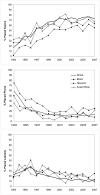Trends and factors associated with infant sleeping position: the national infant sleep position study, 1993-2007
- PMID: 19996049
- PMCID: PMC2898125
- DOI: 10.1001/archpediatrics.2009.234
Trends and factors associated with infant sleeping position: the national infant sleep position study, 1993-2007
Abstract
Objective: To determine trends and factors associated with choice of infant sleeping position.
Design: Annual nationally representative telephone surveys from 1993 through 2007.
Setting: Forty-eight contiguous states of the United States.
Participants: Nighttime caregivers of infants born within the last 7 months; approximately 1000 interviews were given each year. Main Outcome Measure Whether infant is usually placed supine to sleep.
Results: For the 15-year period, supine sleep increased (P < .001) and prone sleep decreased (P < .001) for all infants, with no significant difference in trend by race. Since 2001, a plateau has been reached for all races. Factors associated with increased supine sleep between 1993 and 2007 included time, maternal race other than African American, higher maternal educational level, not living in Southern states, first-born infant, and full-term infant. The effect of these variables was reduced when variables related to maternal concerns about infant comfort, choking, and advice from physicians were taken into account. Between 2003 and 2007, there was no significant yearly increase in supine sleep. Choice of sleep position could be explained almost entirely by caregiver concern about comfort, choking, and advice. Race no longer was a significant predictor.
Conclusions: Since 2001, supine sleep has reached a plateau, and there continue to be racial disparities. There have been changes in factors associated with sleep position, and maternal attitudes about issues such as comfort and choking may account for much of the racial disparity in practice. To decrease sudden infant death syndrome rates, we must ensure that public health measures reach the populations at risk and include messages that address concerns about infant comfort and choking.
Figures
References
-
- Matthews TJ, MacDorman MF. Infant mortality from 2004 period linked birth/death data set. Natl Vital Stat Rep. 2007;55:1–32. - PubMed
-
- Kattwinkel J, Hauck FR, Keenan ME, Malloy MH, Moon RY. Task Force on Sudden Infant Death Syndrome, American Academy of Pediatrics. The changing concept of sudden infant death syndrome: diagnostic coding shifts, controversies regarding the sleeping environment, and new variables to consider in reducing risk. Pediatrics. 2005;116:1245–55. - PubMed
-
- Colson ER, Levenson S, Rybin D, et al. Barriers to following the supine sleep recommendation among mothers at four centers for the Women, Infants, and Children Program. Pediatrics. 2006;118:e243–50. - PubMed
-
- Willinger M, Ko CW, Hoffman HJ, Kessler RC, Corwin MJ. Factors associated with caregivers' choice of infant sleep position, 1994–1998: the National Infant Sleep Position Study. JAMA. 2000;283:2135–2142. - PubMed
-
- Brenner RA, Simons-Morton BG, Bhaskar B, et al. Prevalence and predictors of the prone sleep position among inner-city infants. JAMA. 1998;280:341–346. - PubMed
Publication types
MeSH terms
Grants and funding
LinkOut - more resources
Full Text Sources
Other Literature Sources
Medical
Molecular Biology Databases



